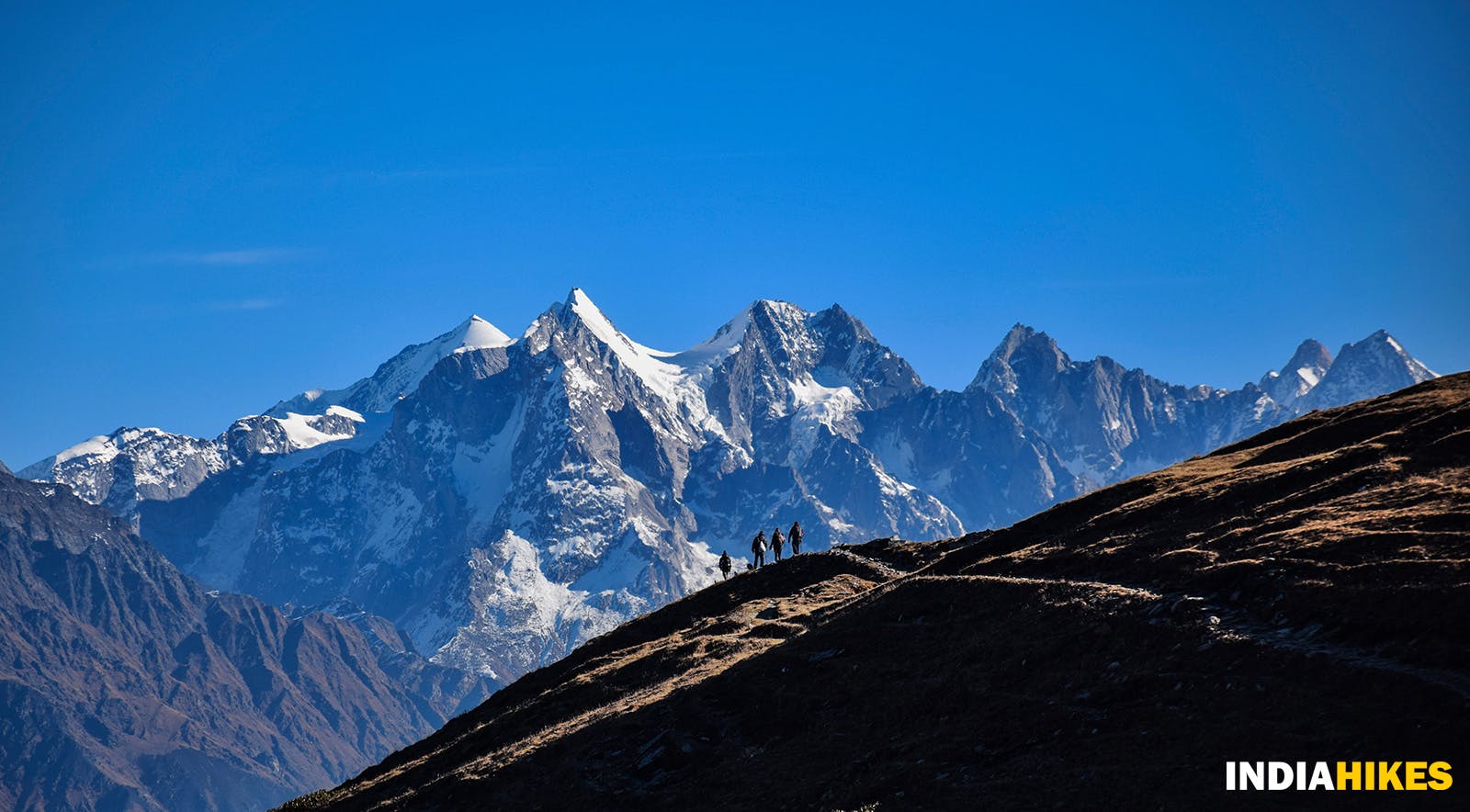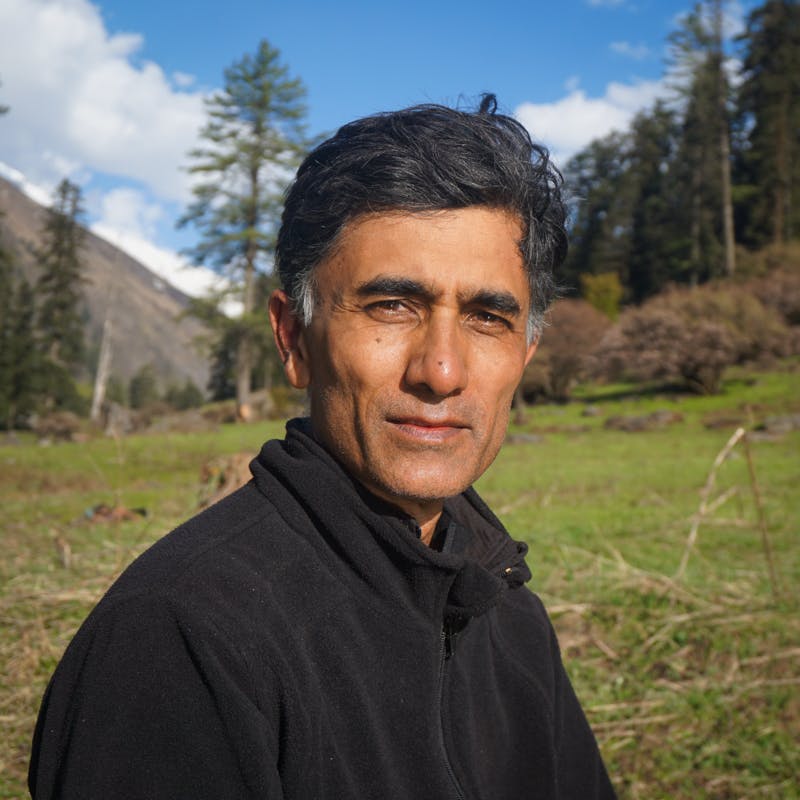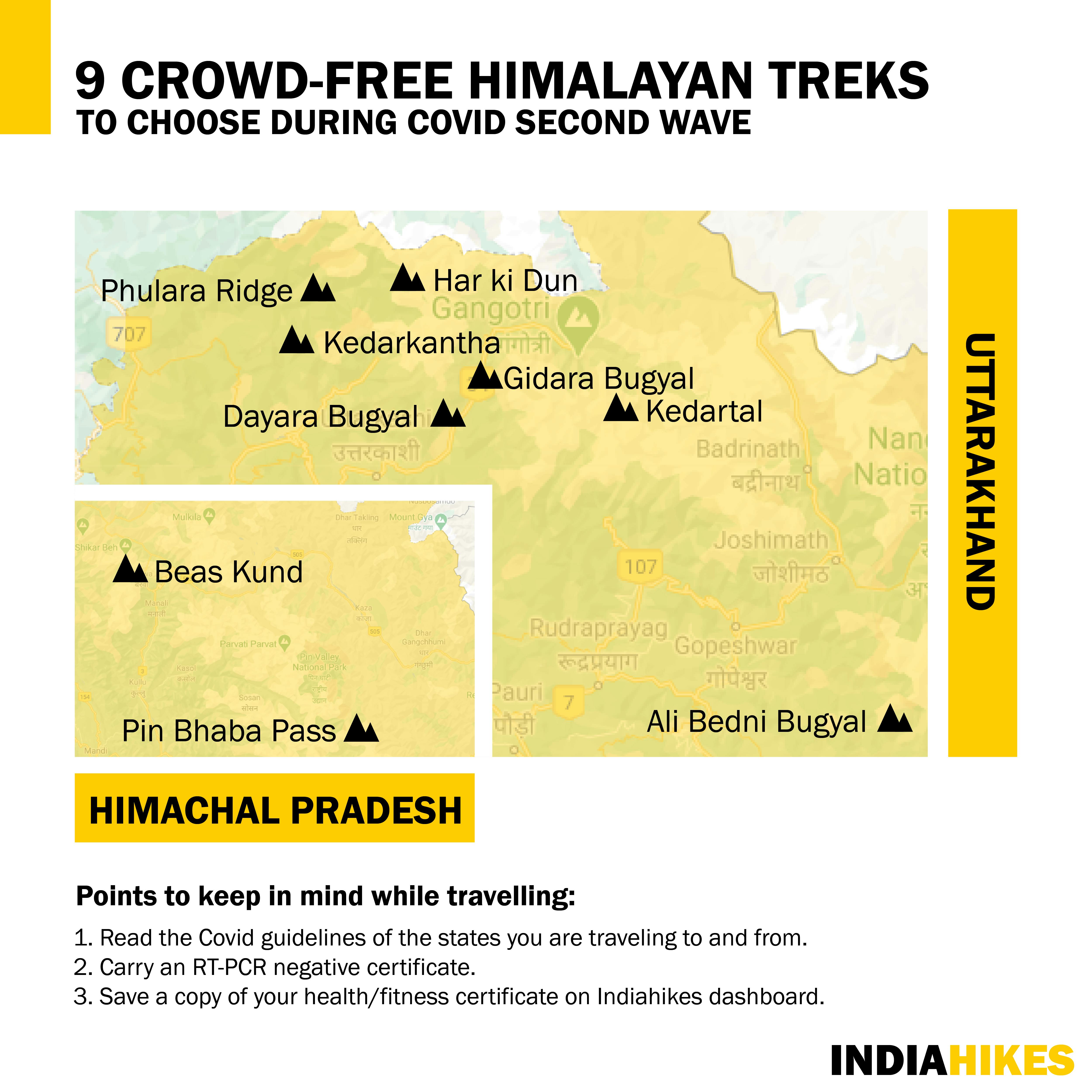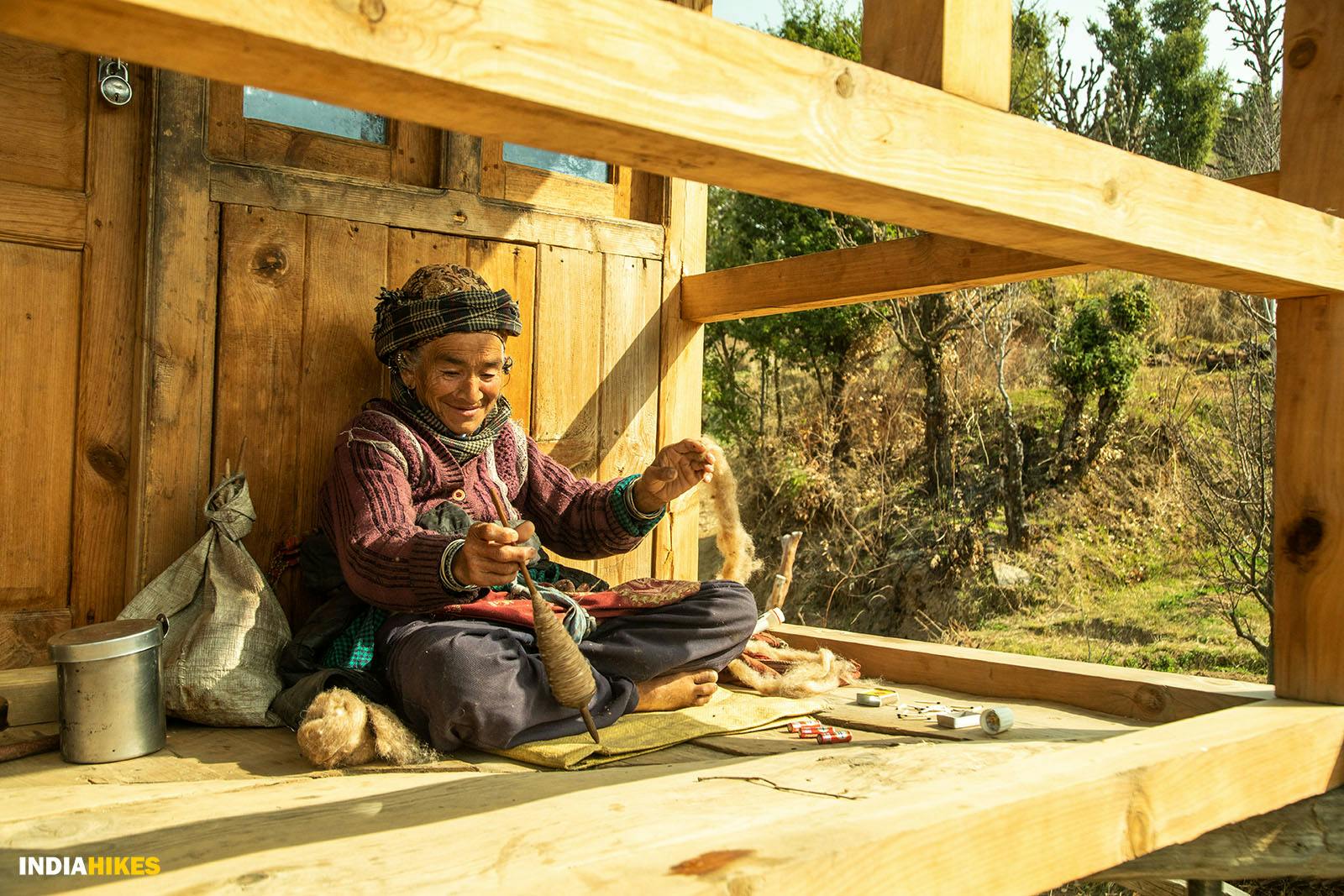How Trek Explorations Are Done: The Phulara Ridge Example
Share this story
How Trek Explorations Are Done: The Phulara Ridge Example
Category Treks That Transformed Indian Trekking About Indiahikes
By Arjun Majumdar
2020-07-23
We have been talking about treks that Indiahikes explored and brought out in Indian trekking. These are treks that have fundamentally changed how we trek in our country. They have made a big impact on trekking.
If these treks did not exist then trekking would not have grown in India. This is the legacy of the Indiahikes exploration team. We have defined new treks for India.
We spoke about the Roopkund, Rupin Pass, Kedarkantha, Chadar Frozen River, and Kashmir Great Lakes.
Today our founder, Arjun Majumdar, zooms out a bit and gives you an insider peek into how trek explorations are done. For that he uses the Phulara Ridge, one of our great new treks as an example.
How Is A Trek Decided For An Exploration?
This is a question that people often ask me. How do you decide on what trek to do?
First, we select a region that we would like to explore
The region is a very big deciding factor. For example, we may feel western Himachal Pradesh, or the Lahaul region may have very few treks that people do — so that’s a region we would look to explore. Or we may think that Kumaon is a region that has not been explored much — so can we look at that region? Or Arunachal has some splendid forests — could those be explored?
In the case of Phulara Ridge, we were very keen to find trails around the Sankri region — there was a self interest in it as well. Over the years we noticed Kedarkantha was getting overcrowded. We knew this region was strikingly beautiful, but we needed to find trails that could match up to Kedarkantha and help take the load off.
For those who don’t know, Sankri is a very big trekking hub of our country. Some of the greatest treks in our country start out of the Sankri region: Kedarkantha, Har-Ki-Dun, Bali Pass, Phulara and even the Rupin Pass. Sankri is in the extreme western borders of Uttarakhand, almost touching Himachal — which is in a very exciting geographic topographical region. The variety in the mountains is superb.
Next, the map plays a very important role
Once we have earmarked a region, we dig deep into maps we have of that region. Topographical maps with contours really help. We want to know where the mountains, rivers, valleys and passes are. We want to see all possible trails around the region.
These give us our first clues. We mentally chalk out trails connecting regions. Say, this village to that through a valley here.
In fact, that’s how the Warwan Valley exploration was done. We wanted to explore a crossover trek from the deserts of Ladakh to the greenery of Kashmir. Was there such a trek? Yes, there were a few. But Warwan Valley seemed the most feasible of the lot. Others looked extremely difficult.
Even the Warwan Valley had two routes — the map helped us choose one of the two mountain passes for our crossover. It is a bit of luck that Warwan Valley turned out to be one of the greatest explorations we have done.
From theory to fact finding
Moving on, finally, comes the stage where we move out of the theoretical and gather first hand information.
This is where we talk extensively with people of that region. You may imagine that we ask them about treks in the region — we don’t do that.
Instead we gather larger information about the region. We ask questions like, Where does this stream go? We notice there is a lake around here, have you been there? Is there a shepherd’s trail that links this side of the grassland to that side?
We hold these discussions over many days and sessions, usually months, slowly absorbing the topography of the region, forming mental maps.
Trek extensions also make for good explorations
This is another aspect of explorations. Sometimes people do not explore extensions of already famous treks. They take what is available as a finality. Unfortunately, that is like knowing a person only by looking at them once. First impressions could be deceptive. Only when you set foot on an extension do you realise how stunning it is.
This is how Har-Ki-Dun’s extension, the beautiful Ruinsara tal, was added to our itinerary. Though it was a famous lake and mountaineers of yore have always talked about, it was an extension to Har-Ki-Dun that few did or talked about. We wondered why.
We always keep a few days in hand to see if other extensions crop up when we explore a region. When we explored the Dayara Bugyal, we always had the Siyari region in mind (ridge extension of Dayara meadows) and even the Gidara Bugyal area. These require more days to explore — they are remote and unknown, but they do throw up great surprises.
Exploring quickly
That’s another thing about explorations — we always try to explore a trail quickly. We want to get an overall idea of the trail first. We want to see if it is great for future trekkers.
When we explored Kashmir Great Lakes for the first time, we wrapped up the trek in 4 days but sauntered around the lakes for an extra day. Later, the trek became a 7 day event.
A trail that typically takes 5 days, we explore in 3 days. We don’t camp at usual places, but mark spots on the way that can make for good campsites.
Later, we revisit the trail a couple of times before we throw it open to the world. Typically, an exploration that we find exciting goes through at least 3-4 further visits. We check for campsites, water, snow, and tricky sections.
The revisit is also required to get a different perspective of the trail. What sounds exciting to the exploration team may not feel great to a regular trekker. So we usually ask our other team members to explore a trail again.
How Phulara Ridge Was Selected For Exploration
I’ll admit, Phulara Ridge was not our first choice for exploration. Even though we had been talking about this region for some time, we were very uncomfortable about a trail that ran so close to Kedarkantha.
The first few times when our staff talked about a shepherd’s trail that went over a long ridge that connected the Sankri region with Taluka, we dismissed the idea. We were not convinced.
On the other hand, another trail in that region attracted us too — the Devkyara meadows. In our gathering of information, we had heard, much to our disbelief, that the meadows were as big and green as Kashmir, with gentle streams running through them. Tall, snow clad mountains towered over the meadows.
It was a bit of a climb to get to the meadows, almost at 14,000 feet, but the settings apparently made up for the effort.
On to Devkyara
Four of us, Sandhya (co-founder of Indiahikes), Suhas (head of exploration and documentation at Indiahikes), Anika and I set off exploring Devkyara in the late spring of 2018. That’s how explorations are — a small team that explores quickly.
Nobody goes alone on explorations, it's always a small, quick team. Apart from the risk of trekking alone there is a practical reason to always explore in teams.
We divide our exploration work among ourselves. I usually write a detailed trek guide. Sandhya takes videos and photos. Someone else takes readings of temperature, altitudes, distances and GPS readings. Some of us are good at finding trails and others are good at navigating unknown territory. Some of us are adept at climbing and cutting a trail through snow. Everyone’s talent is required during an exploration.
Treks come with risks too. We do not want to leave an exploration unfinished because a team member has fallen sick. That’s another reason we explore in teams. Team-work is always great for explorations. On the Devkyara trail there were four of us — which was an ideal size.
On the Devkyara trail we quickly discovered that the trek was rather rough on the legs. All along we had to walk over a trail that was largely paved with stones — it didn’t feel good on the legs. Campsites were very little until we cleared the treeline.
Higher up, though, things changed totally. The settings were remarkable! We were in a high altitude alpine valley with a lovely river flowing along. We camped beside the sandy banks of the river with snow covered mountains surrounding our camp.
Though Devkyara turned out stunning in beauty even under snow, we concluded that the trail was excellent for only small teams (3-4 members). There was very little space to camp lower down the trail. The trail was rough too. We didn’t think it would be ideal for trekkers.
Jumping to Phulara
We quickly descended off the trail. But with the extra days in hand, we were already contemplating another exploration — but it had to be quick.
Jagdish, our ex-senior trek manager, implored us to try Phulara, the ridge that descended down from the flanks of the Kedarkantha, but went many miles over hill tops towards Taloti, a small lake hidden in another high altitude meadow. He said it would be spectacular.
| Note: The trek was not called Phulara then. I am using the name to make it easier for you to understand the trek.
Sandhya and I were skeptical. We didn’t want to rush into another exploration so close to Kedarkantha. The trek Jagdish was talking about had to be something really special to be at par with Kedarkantha.
Yet, we could not ignore what Jagdish was telling us. He was an experienced hand, having grown along with us. He knew what went into explorations.
On the other hand, Sandhya and I wanted to take advantage of the extra days to look into our operations at Sankri. It had been a while since we had been there.
We were torn in our minds. We wanted to explore, but we had our operations work too.
That’s how we asked Suhas if he wanted to explore the trek alone along with Kumresh, one of our most experienced guides of Indiahikes. It could give Sandhya and me that little bit of extra time to look into our operations.
Suhas was taken aback, but pleasantly surprised. I could see him quiver with excitement. These were opportunities that came only once in a lifetime!
Here is the rest of the story in Suhas’ own words:
"The trek started from our famous trail of Sankri to Kedarkantha. The trail went through the lovely pine forest that the Kedarkantha trek is famous for. Instead of going towards the west heading to Juda Ka Talab, we took a diversion in the forest and headed east.
With the lovely aroma of Deodar trees hanging in the air and birds chirping, I came to a clearing. It was a superb clearing surrounded by oaks and deodars, a stream ran close by — it was ideal for a campsite. I marked it for a future campsite of ours.
Just after this clearing I was soon engulfed in another section of the forest. This is where I started spotting Monals, the elusive and shy state bird of Uttarakhand. A couple of them flew just ahead of me.
A while later I had to cross a small broken wooden bridge, and soon the trees started to recede. We were leaving the treeline.
We camped at a pretty meadow called Bhoj Gadi. In the evening with a golden light on our backs, a small stream flowing close by, colors of the sky changing to orange, we cooked our meal on the open ground. I couldn’t have asked for a better setting to camp.
But what turned out the next day was something I could never have imagined!
The ridge walk was stunning. I started seeing snow capped mountains right in front. And more monals flying below me with their spectacular colors.
When I stepped on the ridge and started walking, I was blown away. This was something different compared to all other treks I had done. The 250-degree panorama of snow-capped mountains was jaw dropping. I was on a ridge with nothing on either side!
Trekking on the ridge was unique. I felt the mountains were trekking along with me!
The ridge walk continued for a good four hours. Below me I saw thousands of wildflowers.
On a summit trek, you climb to the top and see the views for about half an hour. But here I was trekking for four to five hours on mountain tops, moving from one to another connected with a ridge. That is uncommon and rare to get!
Once I got off the ridge, I stepped into a spectacular meadows on the other side.
The first sight of the Phustara meadows took me back to the famous Bedni Bugyal campsite on the Roopkund trek. A green carpet spread vast across the entire land. With wildflowers growing in abundance in this haven, it was one of the best spots I had ever seen!
Taloti was a bit farther away from these meadows and across another valley. For me I was taking a chance, but Taloti did not hold much importance after what I had seen on this trek. It was hidden deep in the valley with not many views. I didn’t think it could add more value to the trek. I decided to change the route and head into the forests again.
That night we camped on the Phustara meadows. I thought if I died right there, I would die the happiest person in the world.
The next day I got back into the forest. The forest on this side was very different from the Kedarkantha side. It was denser and more virgin. The silence and sounds in the forest were louder. I again spotted the Himalayan Monals. But other birds were more. I was surrounded by chirping sounds.
When I ended the trek at Taluka, I was flying a few feet off the ground. It was one of the best treks I had ever been on! I couldn’t wait to tell Arjun and Sandhya about this! I rushed back to Sankri."
Naming Phulara
We knew we had a winner the moment Suhas walked into Sankri. His smile said it all. We pumped him for details. The story about the ridge and grasslands that Suhas told us was incredible. He had just explored one of the hidden gems right in our own backyard!
How did Phulara get its name? That’s another side of explorations that is very exciting. If you explore a new trail very often you get to name campsites, locations and clearings — there are still many that are unnamed in our country. But sometimes, just sometimes, once in a lifetime you get to name a new trek. This was one of them.
We sat around our fireside, with cups of tea in our hand. We tossed around a few names — all to do with the ridge because that was the attraction. We thought of “this ridge trek” and “that ridge trek”, but none were sitting well.
It was Suhas who suddenly blurted out, “let’s call it Phulara! I have seen the amount of wildflowers on this trail. The flowers on this trek will do justice to the name.” It sounded splendid! And that’s how the now famous Phulara Ridge Trek got its name.
It was explored by Suhas Saya and it was named by him. In the history of Indian trekking, Suhas will leave this legacy behind. When you think of it, it is unbelievable. That in the modern world there are still places and treks to be named and like Suhas, you can be a part of it!
Impact of Phulara
Within two years since its inception, Phulara has caught the imagination of the trekking world. Our trekkers have fallen head over heels in love with the ridge walk. In our country ridge walks are rare — and then we have Phulara with its astounding views and a never ending walk.
Even though it is an absolute neighbour of the Kedarkantha, it has stood its ground on its own. That’s the beauty of trekking sometimes, how we discover treks right in our backyard, yet completely different to the trek it is close to.
How trekking trails evolve
People often think that trails are permanent once they are set. They aren’t. They evolve continuously as we discover more facets about them.
For instance, the Buran Ghati trail was a straightforward climb to the pass. But we knew of a side trail that took us to an alpine lake on another valley. When we walked on it, we knew that this would excite trekkers. Now the Chandranahan lake is part of the Buran Ghati trek itinerary. So much so that the trek to the lake could become a trail on its own in future.
Earlier this year, in the same Buran Ghati region, we explored a trail stepping away from the usual route through the forest, but walking on hill tops above Janglik village. Bad weather hampered the explorations. But whatever little we saw, had us all excited. Perhaps in future that trail may become the future route for the Buran Ghati trek. Or it may become a trek on its own right.
On the other hand, The Tarsar Marsar trek in Kashmir could have 5 or 6 variations. We have only set foot on a few of them. Now we know there are hidden lakes on these trails that could be as pretty as the ones we camp beside! In future the trek could have a totally new route!
Trails change over time. So do camps. That’s how dynamic they are.
The trail Suhas walked on introduced Phulara to the world. But Phulara has a lot more to be discovered. The extension to the Pachukandi Pass is already exciting. On the other side of the Phulara ridge, there is an exciting route to the Kedarkantha summit. A lot of variations are possible. Over the years the Phulara ridge trek will see its evolution.
In Conclusion — The Beauty Of Explorations
At the end, trek exploration is a lot of research, fact finding, willingness to go on untrodden paths, but is also about creativity. Sometimes it requires a touch of imagination to see the possibilities of a trail.
These figments of our imagination lead us to hidden corners of trails, of new extensions or a completely new path through the mountains.
That’s what makes explorations exciting, fun and a wonderfully joyous experience.
Indiahikes has always been at the forefront of explorations. Most famous trails that our country treks on today have been brought out by Indiahikes. That’s how we have defined the future of trekking.
Not many know that as much as we run treks we are continuously exploring trails too. Most of them never see the light of the day — but our spirit of exploration continues.
I have often been asked by trekkers if they could join us on our explorations. I don’t know if they will make able members of an exploration team. But I would like to know your thoughts. Do you think we must take regular trekkers as members of an exploration team? Let me know your thoughts in the comments below. We may just invite you for our next exploration.
Related Articles
Related Videos
What makes Phulara Ridge an unusual trek
Best time to do the Phulara Ridge trek
A fly-by on the Phulara Ridge route
Sign up for our much loved Weekly Mailer
We have terrific trekking tips, trek updates and trek talks to look forward to




